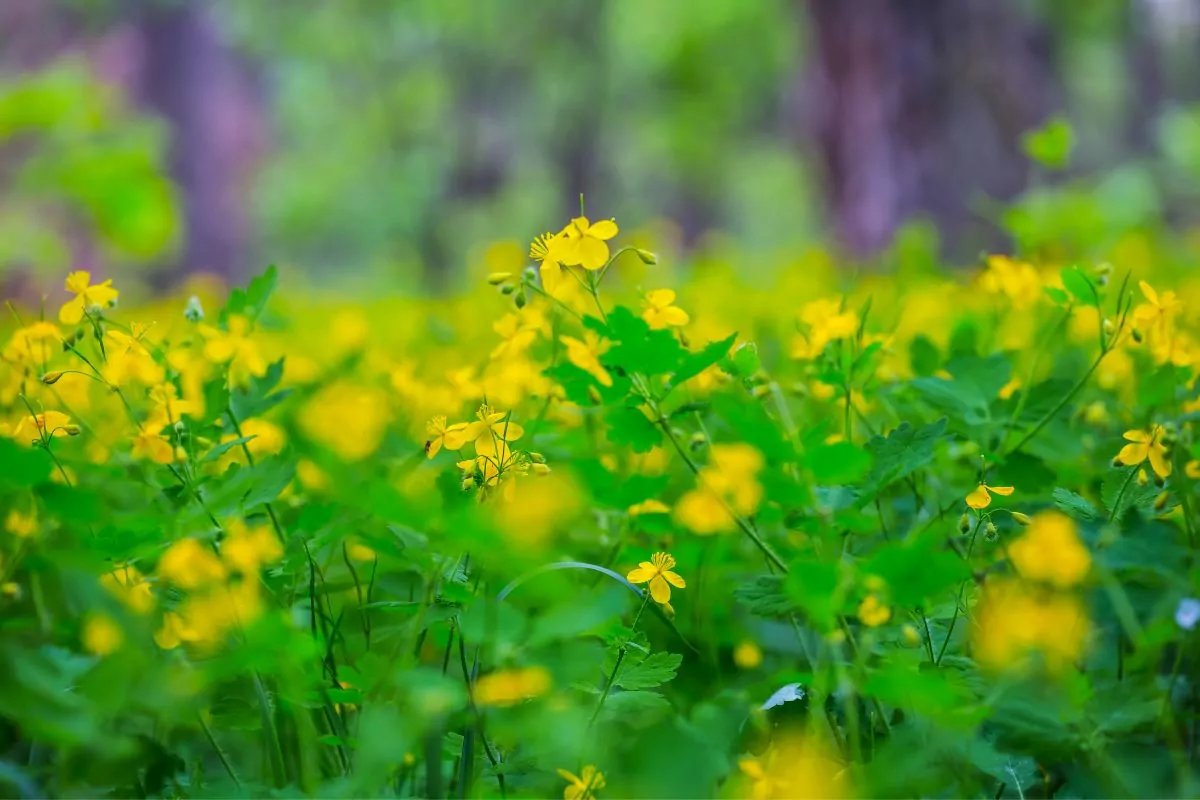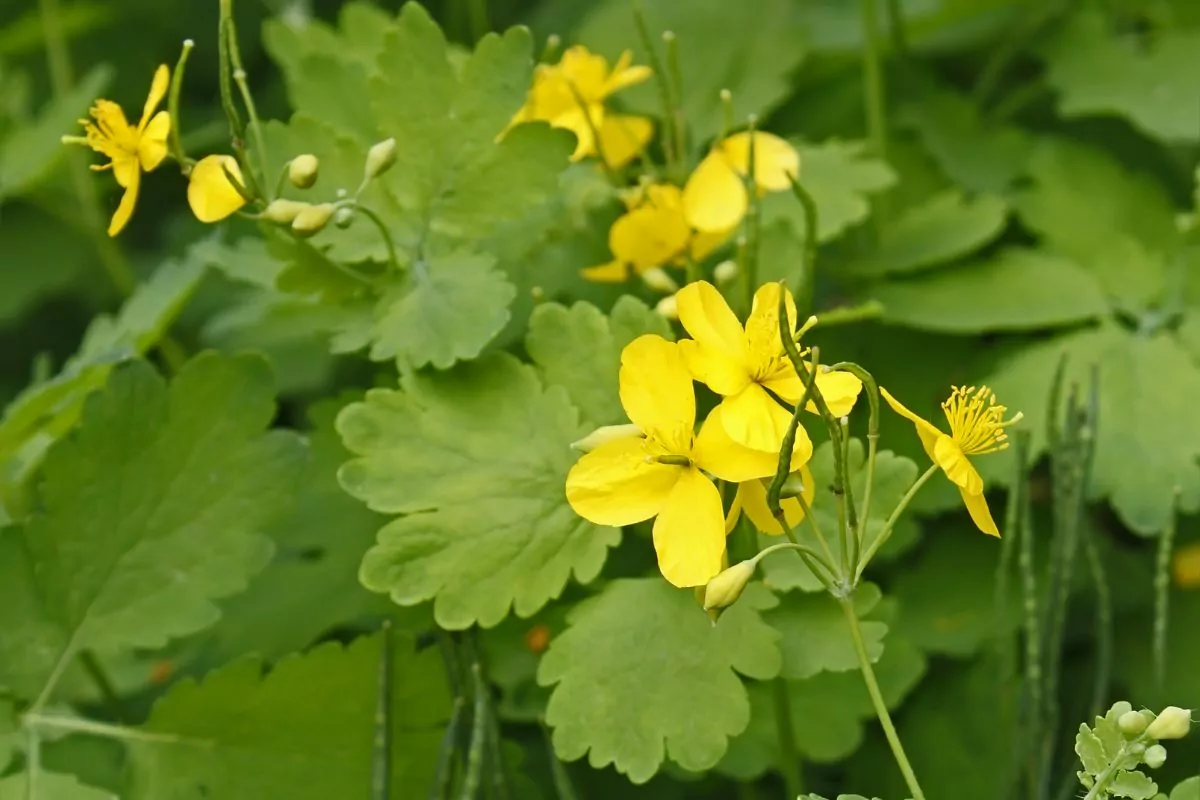If you have ever seen a yellow wood poppy, or a celandine poppy, before, you will know why so many people want to have them in their gardens. They are so beautifully vibrant in color, and look great in most outdoor areas.

Are you thinking about planting some of these flowers, but you’d like to learn more about them before making the commitment?
Or, perhaps you are a brand new yellow wood poppy grower, and you’d like to know more about your new creations.
In this guide, we will be discussing all that you need to know about these super yellow poppies.
The Basics Of The Yellow Wood Poppy
The yellow wood poppy, also known as Stylophorum diphyllum, is a perennial that requires little maintenance and is extremely visually appealing.
It is an excellent complement to most outdoor areas, most notably shade gardens. It is sometimes referred to as just a wood poppy, or a celandine poppy.
We’ve outlined all the essential information regarding this vividly yellow wildflower below.
The Appearance Of A Yellow Wood Poppy
A yellow wood poppy is a colorful, robust variety of poppy, as one may tell from a quick glance.
They are very appealing in gardens, especially in the warmer months of the year, due to their bright yellow or golden-orange flowers and fuzzed, serrated leaves.
The orange and yellow frilly blossoms of the yellow wood poppy add to what makes them such beautiful flowers, with leafy stalks at the base of the plant.
The species’ grooved basal leaves, which contrast attractively with the bright yellow blooms, add to its all-around appeal with their green-blue hue.
The Origin Of The Yellow Wood Poppy
The yellow wood poppy is a native wildflower of Canada that is still present in its home country, as well as in some sections of the United States and other parts of the world.
A poet named Robert Elliot was one of the first to discover wood poppies when he noticed them blossoming along the Thames River in Ontario in the late 19th century.
Over the following years, a few other finds in the area were discovered, but after that, there were no further mentions of this plant for nearly a hundred years.
The wood poppy and its natural surroundings have since been preserved by the Ontario Endangered Species Act, which came into force in the middle of the 1990s.
Since then, in order to safeguard the plant’s survival, we have been attempting to learn more about its ecosystem.
The Average Size Of A Mature Yellow Wood Poppy
At full maturity, the stems and the blossoms of these unusual plants can grow to a height of up to 12 to 18 inches.
They can be pruned to become of a lower stature, albeit they do not always grow to be as tall as 18 inches.
The plant’s blades are lengthy with pubescent tips, and can grow up to 6″ long and 4″ wide.
The stems, which can get rather tall, end in individual flowers or clusters of two to four blossoms, each of which has four rounded petals and measures typically 1 to 2 inches across.
Therefore, the plant itself can grow very tall if it is not pruned and measured carefully. If you prefer taller flowers, this should be no issue.
Even though the flowers are relatively little, the attention-grabbing colors make up for their diminutive size.

How To Grow A Yellow Wood Poppy
For the shady corners of your outdoor space, yellow wood poppies are an excellent minimally maintained accent. They are quite little maintenance to maintain and will add a pop of color to any outdoor space.
These plants demand soil that is rich in nutrients and indirect sunlight due to the fact they are typically found on forest grounds.
Removing the heads (the process of deadheading) of outdated flowers might help to promote additional blooming all year long.
This floral species is incredibly simple to grow from seed and rapidly self-seeds. Additionally, there are no diseases or significant pest difficulties with yellow wood poppies, which is a huge plus.
Their primary drawback is that they might draw some undesirable critters, including slugs. If this isn’t an issue to you, then you should definitely start growing some of your own yellow wood poppies at home!
Light Exposure Requirements For Growing A Yellow Wood Poppy
The yellow wood poppy tends to thrive in indirect illumination, since it is often found in the filtered sunlight of woodlands throughout Canada, and in certain regions throughout the northern US.
They grow best in zones 4 through to 9.
You must be sure to put them in a shady – or a somewhat shady – region as a result. They will grow more slowly and may suffer harm before they are fully mature if they receive exposure to an excessive amount of harsh sunlight.
We recommend planting your yellow wood poppies under some sizable trees or hedges in your outdoor area, or using them to make a beautiful ground cover in shaded stone gardens.
Soil Requirements For Growing A Yellow Wood Poppy
A rich, drainage-friendly soil filled with nutrients will be required for yellow wood poppies in order to replicate the lushness of the woodland floor on which they naturally grow from.
Your poppies will benefit from the minerals and ideal soil conditions that can be provided by adding compost to the soil.
These flowers withstand full shade, an acidic or alkaline pH, and thrive in wet, productive, rich loamy dirt.
Watering Requirements For Growing A Yellow Wood Poppy
Yellow wood poppies need to be watered often upon being planted, but not to the point where they are fully submerged. Root rot may result from using too much water, which will eventually be bad for the plant.
Having said that, it is crucial that you remember to water your poppies on a regular basis, especially if you are experiencing an extended period of drought, or reside in an area that gets a lot of sunlight.
These plants will fall into dormancy if the soil is too dry.
In exceptionally dry months, adding a thin layer of mulch on the surface of the soil will assist the plant to absorb and preserve moisture. Once more, you want the soil to be damp but not drenched; add just enough water to keep it moist.
Fertilizing a Yellow Wood Poppy
Your yellow wood poppies might not require any fertilizer in order to assist their growth if you are cultivating them in some good soil.
Everything should be OK as long as you take the initiative to add a tonne of rich, organic stuff, like compost, and you keep watering the plant regularly!
However, if you want to encourage faster development and blooming, you may apply liquid fertilizer once a month during the period of growth.
Although it is not necessary, doing this is a good approach to enhance the growth, general beauty, and health of yellow wood poppies.
Should I Prune my Yellow Wood Poppy Plant?
You might be considering how frequently you’ll need to spend time pruning your yellow wood poppies. The truth is that these plants hardly ever need to be pruned, thus doing so is not necessary to promote growth.
After they have bloomed, you could choose to prune the branches back, since this will prevent your plants from self-seeding.
Just be certain to remove all of the debris with a rake once you’ve done so, as this can cause a little bit of a mess in your garden.
The Best Way To Propagate And Grow Yellow Wood Poppies
The most effective way to reproduce these plants is by division, so keep that in mind when you’re growing these kinds of plants. This entails removing your initial plant and propagating it into multiple plants.
Use a garden shovel to carefully remove your yellow poppy in the spring. With your hands, loosen the roots a little bit while attempting to keep as much soil in the roots as you can.
Then, divide the root system into several pieces with a sharp pair of garden scissors, making sure to maintain growth points for each incision.
On the other hand, it is also pretty easy to propagate yellow wood poppy seeds.
Set the seeds wherever you want your new poppies to sprout, and only lightly mulch them with some soil. Once planted, you should water the soil frequently to keep it hydrated!
Since seeds sown in the fall will sprout in the spring, you should allow them to overwinter in the ground. The following year, you will be rewarded with tiny poppy seedlings.
You might need to prune out your poppies, or relocate the seedlings shortly after they reach around 4 to 6 inches tall.
To prevent them from stealing nutrients from nearby poppies, space them at least 10 to 12 inches apart if you plan to move them.
How To Repot And Replant Yellow Wood Poppies
As we have already discussed plenty of times in this guide, yellow wood poppies need to be planted in soil that is high in organic matter. Therefore, you will need to add some organic soil into whichever pot you plan on using.
After doing so, you can put the potted yellow wood poppies in a shady spot, and maintain watering them regularly.
Additionally, you should always check for holes for drainage in your container because these will aid in the water’s exit. Overwatering can cause problems for your plant, such as root rot.
You might need to water your poppies more frequently to maintain their moisture because they have a limited growing area.
Final Thoughts
If you have enough shade in your garden to plant a couple yellow wood poppies, we say that you should go for it! Just be sure that you have some organic soil on hand, and to remember to keep them hydrated as they continue to grow.
However, do not forget that you should never overwater a yellow wood poppy. Keep it moist, and don’t overdo it!
We hope you found this guide on yellow wood poppies helpful.
Happy gardening!
- Interesting Flowers That Start With A - July 21, 2023
- Interesting Flowers Beginning With H - July 21, 2023
- 14 Fascinating Flowers That Begin With C - July 20, 2023
